new posts in all blogs
Viewing: Blog Posts Tagged with: Jason Reynolds, Most Recent at Top [Help]
Results 1 - 9 of 9
How to use this Page
You are viewing the most recent posts tagged with the words: Jason Reynolds in the JacketFlap blog reader. What is a tag? Think of a tag as a keyword or category label. Tags can both help you find posts on JacketFlap.com as well as provide an easy way for you to "remember" and classify posts for later recall. Try adding a tag yourself by clicking "Add a tag" below a post's header. Scroll down through the list of Recent Posts in the left column and click on a post title that sounds interesting. You can view all posts from a specific blog by clicking the Blog name in the right column, or you can click a 'More Posts from this Blog' link in any individual post.
As the year comes to a close, we here at First Book like to reflect on the things we did, the people we met, and (most of all) the books we read. Here are a few of our favorite children’s books that were published in 2016!
Pre-K –K (Ages 3-6):
 Love you, Hug You, Read to You! / ¡Te Amo, Te Abrazo, Leo Contigo! by Tish Rabe
Love you, Hug You, Read to You! / ¡Te Amo, Te Abrazo, Leo Contigo! by Tish Rabe
“There are three things I’ll always do … love you, hug you, read to you!” The simple promise of togetherness offered in this bilingual (Spanish and English) board book is enhanced by interactive prompts throughout, encouraging parents to engage with their child while reading.
We love this book because: it has interactive prompts throughout the story that encourage listeners to really engage with it, and it helps young readers feel the joy of reading together with friends and family members.
For 1st and 2nd Grade (Ages 6-8):
 Penguin Problems written by Jory John and illustrated by Lane Smith
Penguin Problems written by Jory John and illustrated by Lane Smith
Do you think life in Antarctica is a paradise? Well, the main character of this book will tell you that life isn’t all fun and games for penguins. Penguins have problems just like we do!
We love this book because: the characters are engaging and adorable. The descriptions of the penguin’s “problems” makes the title a fun read aloud. The story may seem to have pessimistic themes at first, but has an uplifting ending. We love this book so much, we dressed up like the characters for Halloween this year!
For 1st – 3rd grade (Ages 6-9):
 One Vote, Two Vote, I Vote, You Vote! by Bonnie Worth
One Vote, Two Vote, I Vote, You Vote! by Bonnie Worth
The Cat in the Hat knows about a lot of things! In this book, he introduces young readers to the concept and practice of voting for the American presidency. Written in simple rhyme, readers learn the basic principles of democracy, how political parties are formed, why Election Day is held in early November, and much, much more!
We love this book because: Memorable stanzas coupled with familiar illustrations make this title a fun way to introduce kids to the American electoral system. The title’s publisher, Random House Kids Books, even held an election to encourage the book readers to vote for a cause for The Cat to donate to – and we won!
For 4th – 6th grade (Ages 10-12):

As Brave As You
Genie’s summer is full of surprises. The first is that he and his big brother, Ernie, are leaving Brooklyn for the very first time to spend the summer with their grandparents all the way in Virginia—in the COUNTRY! The second surprise comes when Genie figures out that their grandfather is blind.
We love this book because: The book approaches heavy topics, but remains relate-able for young readers. Drawing from his own experiences growing up, author Jason Reynolds paints portraits of multi-dimensional characters. No matter what your background, you’ll empathize with Genie & Ernie as they get to know their grandfather and more about themselves.
Read & watch our Q&A with author Jason Reynolds.
Grades 7 & up (Ages 13+):
 March, Book 3 by John Lewis
March, Book 3 by John Lewis
Welcome to the stunning conclusion of the MARCH trilogy. Congressman John Lewis, an American icon and one of the key figures of the civil rights movement, joins co-writer Andrew Aydin and artist Nate Powell to bring the lessons of history to vivid life for a new generation, urgently relevant for today’s world.
We love this book because: The “March” series tells a first-person account of an important time in American history – a story that must be told, and remembered (Find book one here, and book two here). The “March” series is a must for every classroom.
So many wonderful books were published this year – it’s so hard to pick just five! If you’d like to see the full listing of our favorite books published in 2016 that we’ve made available for children in need, please visit the First Book Marketplace!
The post Monthly Book List: Our Five Favorite New Books of 2016 appeared first on First Book Blog.


By:
Cynthia Leitich Smith,
on 11/28/2016
Blog:
cynsations
(
Login to Add to MyJacketFlap)
JacketFlap tags:
poetry,
diversity,
middle grade fiction,
nonfiction,
ncte,
Melissa Sweet,
Marilyn Nelson,
Jason Reynolds,
awards,
Add a tag
By
NCTEfor
CynsationsATLANTA-- Authors Jason Reynolds, Melissa Sweet, and Marilyn Nelson were just announced winners of
prestigious literacy awards from the National Council of Teachers of English (NCTE).
Jason Reynolds won the 2017 Charlotte Huck Award for Outstanding Fiction for Children for his book
Ghost (Atheneum). The Charlotte Huck award is given to books that promote and recognize fiction that has the potential to transform children's lives.
Melissa Sweet won the 2017 Orbis Pictus Award for Outstanding Nonfiction for Children for her book
Some Writer!: The Story of E.B. White (Houghton Mifflin Harcourt).
The NCTE Orbis Pictus Award, established in 1989, is the oldest children's book award for nonfiction.
Marilyn Nelson won the 2017 NCTE Award for Excellence in Poetry for Children. The biannual award is given to a living American poet for his or her aggregate work for children ages 3–13.
Honor and Recommended book lists were also announced. All three authors will be invited to speak at next year's NCTE Annual Convention in St. Louis, MO.
NCTE is the nation's most comprehensive literacy organization, supporting teachers across the preK–college spectrum.
Through the expertise of its members, NCTE has served at the forefront of every major improvement in the teaching and learning of English and the language arts since 1911.
So often a cover reveal is just that. A reveal. Here’s your cover, batta bing, badda boom.
Today is different.
Today, we’re shaking things up a tad. But a little backstory first.
About half a year ago I had the pleasure of speaking at the MD/DE/WV SCBWI Conference in Frederick, Maryland. I like doing SCBWI Conferences. The people there are open and fun and often have these great ideas I don’t see elsewhere. I do about one a year, and this one was particularly lovely. In the course of things I met a woman with a debut middle grade coming out in 2017. She asked if I would do a cover reveal for her, and I said sure thing. Why not? Then she sent me the book jacket.
Friends, I don’t know if you’re aware of it, but some people are born with book jacket luck. If you’re an author, you have no control over the jackets your well-meaning publishers plaster on your books. Sometimes you luck out but all too often you just have to grin and bear whatever cover they slap on your baby (and God help you if it’s sepia-toned). But this young woman, Leah Henderson, need not worry. Surely, she was tapped upon the noggin at her christening by some good book jacket fairy because the artist of her cover is none other than John Jay Cabuay, the artist behind this year’s jacket for As Brave As You by Jason Reynolds.
Ladies and gentlemen, I give you One Shadow on the Wall by Leah Henderson. Baby, remember her name.
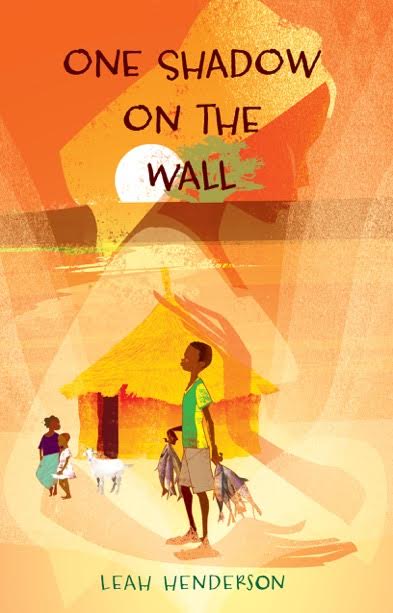
But it doesn’t stop there. Leah was nice enough to also share the full wrap jacket both without the text:
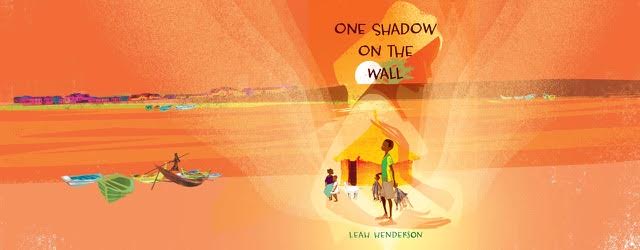
And with the text:
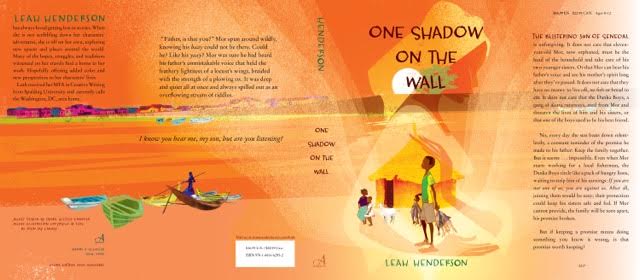
Beautiful. Now here’s the description:
An orphaned boy in contemporary Senegal must decide between doing what is right and what is easy as he struggles to keep a promise he made to his dying father in this captivating debut novel laced with magical realism.
Eleven-year-old Mor was used to hearing his father’s voice, even if no one else could since his father’s death. It was comforting. It was also a reminder that Mor had made a promise to his father before he passed: keep your sisters safe. Keep the family together. But almost as soon as they are orphaned, that promise seems impossible to keep. With an aunt from the big city ready to separate him and his sisters as soon as she arrives, and a gang of boys from a nearby village wanting everything he has—including his spirit—Mor is tested in ways he never imagined. With only the hot summer months to prove himself, Mor must face a choice. Does he listen to his father and keep his heart true, but risk breaking his promise through failure? Or is it easier to just join the Danka Boys, whom in all their maliciousness are at least loyal to their own?
One Shadow on the Wall is about love and loss, family and friendship, and creating your own future—even if it’s hard to do.
Now if you know me then you know that I don’t go in for giveaways. I don’t have anything against them. They’re just not a tool in my belt, as it were. But Leah came to me with an interesting proposition. She has a Twitter giveaway going on with this book, and it’s been done with the specific purpose of promoting her cover artist. She’s not giving away her galley (the book comes out June 6, 2017 and they haven’t made the ARCs yet). She has something else in mind. As she puts it,
“I wanted to find a way to give a nod to the illustrator and his work. And since fellow Atheneum author, Jason Reynolds’ MG debut AS BRAVE AS YOU is also by John Jay Cabuay, I thought it might be a perfect way to highlight both of them and my love of MG, since my ARCs won’t be ready.
So I thought:
For a chance to win a signed copy of fellow Atheneum author, Jason Reynolds’ MG debut AS BRAVE AS YOU and a few pieces of ONE SHADOW ON THE WALL swag, simply share this post on Twitter mentioning why you love/read middle grade using the hashtag: #whyMGlit.
I’ll pick my favorite response around noon EST on Nov. 10th.”
That’s a pretty good deal. Reynolds’ book has been getting a lot of Newbery buzz, so you’d be getting a great book of 2016, and a leg up on what may well be the most beautifully jacketed book of 2017.
Some background information on Leah herself:
About the author
Leah has always loved getting lost in stories. When she is not scribbling down her characters’ adventures, she is off on her own, exploring new spaces and places around the world. She received her MFA in Creative Writing from Spalding University and currently calls Washington D.C. home.
You can find Leah on Twitter at @LeahsMark. And, if interested, can add her book to your Goodreads bookshelf.
Goodreads: https://www.goodreads.com/book/show/30312781-one-shadow-on-the-wall?ac=1&from_search=true
Pre-orders are up too:
Indiebound : http://www.indiebound.org/book/9781481462952?aff=simonsayscom
Amazon : https://www.amazon.com/One-Shadow-Wall-Leah-Henderson/dp/1481462954/ref=sr_1_1?ie=UTF8&qid=1476645842&sr=8-1&keywords=one+shadow+on+the+wall
Barnes and Noble : http://www.barnesandnoble.com/w/one-shadow-on-the-wall-leah-henderson/1123862060?ean=9781481462952
Thanks to Leah for the cover reveal, and much luck with your book!


By: Marissa Wasseluk,
on 8/19/2016
Blog:
First Book
(
Login to Add to MyJacketFlap)
JacketFlap tags:
Books & Reading,
Authors & Illustrators,
author interview,
Jason Reynolds,
stories for all,
diverse books,
all american boys book,
author jason reynolds,
ghost book,
Add a tag
Author Jason Reynolds’ books start the conversations about the difficult issues facing kids today. His experiences, as told through the characters in his stories, are very much like those of the children we serve – which is why we feel it’s so important for them to hear Jason’s voice.
We had the opportunity to talk with Jason about his experiences, his journey to becoming an author, and how he’s seen his books affect young readers.

Q. Were you an avid reader as a child?
A. Absolutely not. I actually didn’t read much at all, though I had books all around me. Most of them were classics. Canonical literature. But to a kid growing up in the midst of the hip-hop generation, a time where most young people of color were exposed to the hardships of drugs and violence, I gravitated more toward the storytelling of rap music, than I did the dense and seemingly disconnected narrative arc of books (during that time).
Q. What stories or poetry did you connect with as a young person? Did you have trouble connecting with stories as a child?
A. I had a really hard time connecting with stories as a child, especially within the confines of a book. But I was introduced to poetry by reading the lyrics of Queen Latifah, Tupac, Slick Rick, and lots of other rappers. From there, I started to make connections between their lyrics and the poetry of Langston Hughes and Maya Angelou. But eventually I began reading more traditional narratives, the first being Black Boy, by Richard Wright. It changed my life.
Q. Are there books you’ve read today that you wish you’d been exposed to as a child or young adult?
A. All of Walter Dean Myers’s work. Also, I wish there would’ve been as much focus on graphic novels back then, as there is now. That would’ve been extremely valuable to me.
Q. We first met you as a writer through your poetry in My Name is Jason. Why did you make the transition into writing novels? And how is your process for writing poetry different than writing novels?
A. I never wanted to write novels, so you can blame Christopher Myers for that. He’s the one who challenged me to give it a shot. My plan was to be only a poet. But there was something in Walter Dean Myers’s stories — a permission to be myself on the page I hadn’t felt before. So I let myself be myself, let my language live freely on the page without the pretense and pressure of the academy or some phantom scholarship. And turns out, it worked! Now, the poetry was a big help mainly because as a poet I valued the importance of beginning and ending, which has lent itself to my work tremendously.
Q. You toured extensively with Brendan Kiely for All American Boys. Can you recount a few of the most powerful moments you had with students and/or with adults while on tour?
There were so many. One thing that was interesting was, everywhere we went we would ask the students the same two questions: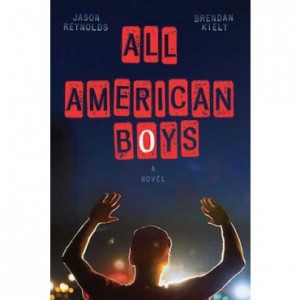
1.) How many of you know about police brutality? They’d all raise their hands. And,
2.) How many of you have spoken to your friends about it? Ninety percent of the hands went down.
We realized that kids knew about it but weren’t discussing it, but we also deduced that it wasn’t because they didn’t want to talk about it, but instead was because they didn’t have the framework or the safe space to do so. By the end of our presentation, everyone always had questions and comments, ready for the hard conversation. Some other interesting moments . . . We met a man in Cincinnati, a white man raising two black boys. He came over to us and explained that All American Boys had helped him understand what his sons might be facing outside of his home, and that he needed to be as open as possible and as emotionally and mentally equipped so that he could serve as not only their father, but as their ally. He even said reading the book helped him feel more whole. I also had a student come to me, a young black girl in Philly, who wanted to know if I ever wished I could change the color of my skin, just because she was afraid of the fear other people have of it. She was in the seventh grade, and in that moment I got to pour into her. Tell her that she was perfect the way she was. I have tons of these stories. Mexican kids in Texas who wondered what their role is. Wealthy white boys in Baltimore forming cultural sensitivity groups in their schools. Even recently watching a group of students perform the theatrical version of All American Boys in Brooklyn. Young people are ready to talk. And they’re ready to act. We (adults) just have to arm them.
 Q. Do you see your teenage self in any of your novels? If so, which one(s) and in what ways?
Q. Do you see your teenage self in any of your novels? If so, which one(s) and in what ways?
A. I’m in all of them. Each and every one of them. I like to pull from actual stories from my teenage years, like Ali and the MoMo party in, When I Was The Greatest, or Matt Miller and his mother’s cancer in, The Boy in The Black Suit. I’m always the protagonist, at least parts of me. Writing is cathartic for me, and a way to process parts of my life that I’ve either worked hard to hold on to, or have desperately tried to forget.
Q. How important was it to have a co-author for Quinn’s voice in All American Boys?
A. It was paramount. The truth is, I might’ve been able to write a decent book, based around Rashad’s narrative, but what Brendan brings to the story with Quinn is, to me, the most important part of the story. It’s the part we don’t hear about, and the part most necessary to sit with and dissect when it comes to making change. It’s something I’m not sure I could’ve written with the same authenticity as Brendan, and I couldn’t have asked for a better partner on that project.
Q. Why do you feel it’s important for kids of varied backgrounds to read the stories you write?
A. You know, I think about this often, and I think ultimately what I hope is that they read my books and feel cared for. Feel less alone. There’s an impenetrable power to simple acknowledgement.
Q.Why is it important for kids, especially kids from low-income communities, to have access to brand-new books?
A. It’s important for kids from low-income communities to have brand-new anything. But if it could be a book, let alone a book that speaks directly to their experiences, then it’s a double-win.
Watch the video below for more insights from Jason:
Thanks to the support of Jason Reynolds’ publisher, Simon & Schuster, 20,000 of Reynolds’ young adult and middle grade titles will be distributed to children in need through First Book.
The post Q&A with Author Jason Reynolds appeared first on First Book Blog.


By:
Betsy Bird,
on 8/10/2016
Blog:
A Fuse #8 Production
(
Login to Add to MyJacketFlap)
JacketFlap tags:
Reviews,
middle grade fiction,
Simon and Schuster,
Atheneum,
Best Books,
middle grade realistic fiction,
Jason Reynolds,
Best Books of 2016,
2016 reviews,
Reviews 2016,
2016 middle grade fiction,
2016 realistic fiction,
diverse fiction,
Add a tag
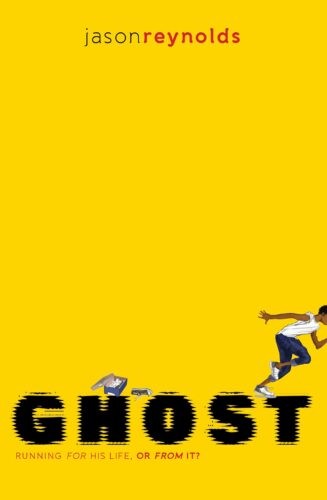 Ghost
Ghost
By Jason Reynolds
Atheneum (an imprint of Simon & Schuster)
$16.99
ISBN: 978-1-4814-5015-7
Ages 9-12
On shelves August 30th
This is a generalization, but in my experience librarians really enjoy reading within their comfort zones. They’ll travel outside of them from time to time but always they return to the books that they like the most. Children’s librarians are just the same. The fantasy readers stick to fantasy. The realism fans go with realism. Graphic novel readers with comics. When I served on a yearly committee of librarians in New York I’d notice that some books were difficult to get anyone to read. Horse books, for example, just sat on our shelves untouched. Nonfiction could take some prodding. And as for sports books . . . forget about it. Nobody ever got near them. Still, you can’t give up on them. Mike Lupica and Tim Green may rule the field but that doesn’t mean other people don’t make a lot out of athletics. If our Newbery winning The Crossover by Kwame Alexander taught us anything, it was that. Now Jason Reynolds, a young adult author until this year, has produced a middle grade novel centered on that must unlikely of sports: track. It skirts the clichés. It dodges the usual pitfalls. It makes you care about a kid who keeps messing up over and over and over again. It’ll make you like sports books, even if you can’t generally stand them. And now we’ve got to find a way to get a lot of it into the hands of kids. Stat.
Call him Ghost. You can call him Castle Crenshaw if you want to (that’s technically his name) but he’s been calling himself Ghost ever since the night his dad got drunk and threatened Castle and his mom with a gun. Ghost learned to run that night and you might say he’s been running ever since. He’s got a load of anger inside that he doesn’t know how to deal with so he tends to take it out on others at school. Then one day he spots a track warm-up and takes an instant dislike to the albino kid in the expensive tracksuit. Without thinking about it twice Ghost beats the guy on the track, running on the outside, which gets the attention of the coach. Coach begs Ghost to join and Ghost reluctantly agrees but it isn’t what he expected. The other kids there all have their own lives, few of them easy. The running is much harder than anything Ghost has ever experienced before. And then there’s the fact that no matter how fast he is, Ghost can’t run away from trouble. It follows him and if he’s not careful it’s going to follow him right onto the track.
Baseball. Basketball. Even football. These are the sports of fiction. I doubt anyone has ever run any statistics on it, but if you were to gather together all the children’s sports books and group them by type, the baseball books would undoubtedly outweigh all the others 2:1. That’s because baseball is a game with a natural rise and fall to its action. Basketball has speed and football has brute force, all good things when writing a story. Track? In track you run and then you stop. At least that’s how I always looked at it. For Jason Reynolds, though, it’s different. He didn’t write this book with track as a single focus. He looks at what the sport boils down to. Basically, this is a book about running. Running from mistakes (forgive the cliché), from very real threats, for your life, and for your team. Why you run and where you run and how you run. And if that’s where you’re coming from, then track is a very good choice of a sport indeed.
On paper, this book looks like it’s the sort of story that’s all been done before. That’s where Reynolds’ writing comes in to play. First off, it’s worth noticing that Mr. Reynolds is blessed with a keen sense of humor. This comes to play not just in the text but also in little in-jokes here and there. Like the fact that one of the runners (that, I should mention, gets cut later in the book because his grades are slipping) is named Chris Myers. Christopher Myers is the son of Walter Dean Myers, and a friend to Jason Reynolds. I love Jason’s descriptions too. Mr. Charles at the corner store, “looks just like James Brown if James Brown were white. . .” Or Ghost saying later, “… for something to make you feel tough, you gotta be a little bit scared of it at first.” There are some pretty fantastic callbacks hidden in the story as well. Right at the start, almost like it’s some kind of superhero origin story, we hear how Ghost heard the gun go off that night he ran away from his home with his mom and “I felt like the loud shot made my legs move even faster.” That ties in beautifully with the starter pistol that goes off at the very very end of the book.
But maybe what I like the most about Jason Reynolds’ books is that he applies this keen sense of the complexity to his characters. I don’t think the man could write a straight one-dimensional villain to save his soul. Even his worst characters have these brief moments of humanity to them. In this case, Ghost’s dad is the worst character. You don’t get much worse than shooting at your wife and kid after all. Yet for all that, Ghost still can’t help but love the guy and eats sunflower seeds in his memory. Each character in the book has layers that you can peel away as the story progresses. Even Ghost, ESPECIALLY Ghost, who makes you want to yell and him and cheer for him, sometimes at the same time.
There’s been a monumental push for increased diversity in children’s literature in the last few years. Diversity can mean any number of things and it often focuses on race. In a weird way, increasing the number of racially diverse books on a given publisher’s release calendar isn’t hard if the publisher is dedicated to the notion. Far more difficult is figuring out how you increase the economic diversity. Middle grade characters are almost always middle class. If they’re working class then they tend to be historical. Contemporary lower income kids in realistic novels are almost unheard of. For example, how many books for children have you ever read with kids living in shelters? I’ve read just one, and I’m a children’s librarian. So I watched what Reynolds did here with great interest. Ghost isn’t destitute or anything but his single mom makes ends meet by working long hours at a hospital. Middle class kids are remarkably good at ignoring their own privilege while kids like Ghost become almost invisible. In the book, Ghost’s decision to initially race Lu isn’t solely based on how Lu struts around the track, thinking he’s the bee’s knees. It’s also on his clothes. “…Lu, was decked out in the flyest gear. Fresh Nike running shoes, and a full-body skintight suit . . . He wore a headband and a gold chain around his neck, and a diamond glinted in each ear.” Later Ghost makes a decision regarding a particularly fancy pair of running shoes. That’s an economic decision as well. Those are the most obvious examples, but the book is full of little mentions, peppered throughout, of where Ghost’s class comes in to things. It’s nice to see an author who gets that. We are often affected by forces outside our control, forces we don’t even necessarily notice, particularly when we’re children. If young readers see it, they’ll be reading between the lines, just like Reynolds wants them to.
Right at the beginning of the book, when Coach is trying to convince Ghost’s mom that he should be running, Ghost realizes that he’s in a situation that’s played out in loads of sports films. He thinks, “If this went like the movies, I was either going to score the game-winning touchdown (which is impossible in track) or . . . die.” Sometimes you can gauge how good a book is by how self-aware its characters are. But sometimes you just read a book, put it down, and think, “Man. That was good. That was really good.” This is a book that actually made me tear up, and there aren’t a lot of middle grade books that do that. I was rooting for Ghost hard, right until the end. I was caring about a sport that I’d never otherwise think about in a million years. And I was admiring it from start to finish for all that it accomplishes in its scant 180 pages. This is the book you hand to the kids who want something real and good and honest. There are a lot of Ghosts out there in the world. Hopefully some of them will discover themselves here. Run, don’t walk, to pick this book up.
On shelves August 30th.
Source: Galley sent from publisher for review.
Like This? Then Try:


By: Samantha McGinnis,
on 4/19/2016
Blog:
First Book
(
Login to Add to MyJacketFlap)
JacketFlap tags:
Favorite books,
Mary Ann Rodman,
How to Steal a Dog,
Fran Manushkin,
Emily Jenkins,
Barbara O'Connor,
E.B. Lewis,
Lauren Tobia,
Jason Reynolds,
My Best Friend,
Happy in Our Skin,
Brendan Kiely,
Inside First Book,
Our Recommendations,
a Toughy Little Buffalo,
Ages and Grades,
All-American Boys,
and Someone Called Plastic,
books lists,
Coretta Scott King Author Honor,
Monthly book list,
Paul O. Zelinksy,
Toys Go Out: Being the Adventures of a Knowledgeable Stingray,
Walter Dean Myers Award,
Add a tag
Our favorite books for April teach some important lessons!
One celebrates the human body and diversity, while others teach kindness and the keys to a true friendship. You’ll find a story that will help foster kids’ sense of empathy and understanding and an award-winning novel that tackles the topics of prejudice and police brutality.
For Pre-K –K (Ages 3-6):
 Happy in Our Skin written by Fran Manushkin and illustrated by Lauren Tobia
Happy in Our Skin written by Fran Manushkin and illustrated by Lauren Tobia
This affirming and informative book is a charmer and a true celebration – both of diversity and of the human body! Kids will enjoy poring over the diverse faces and hidden details on these pages as they learn about the important role skin plays in their lives.
For 1st and 2nd Grade (Ages 6-8):
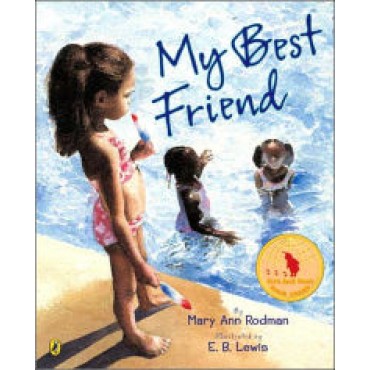 My Best Friend written by Mary Ann Rodman and illustrated by E.B. Lewis
My Best Friend written by Mary Ann Rodman and illustrated by E.B. Lewis
Friendships and healthy relationships – those are two key themes of this read-aloud that will have your students’ undivided attention. Honest and relatable, it perfectly illustrates the confusion kids experience when they want to be liked but set their targets on the wrong person. This book will help them understand that a true friend treats others the way we all want to be treated – with kindness.
For 3rd & 4th grade (Ages 8-10):
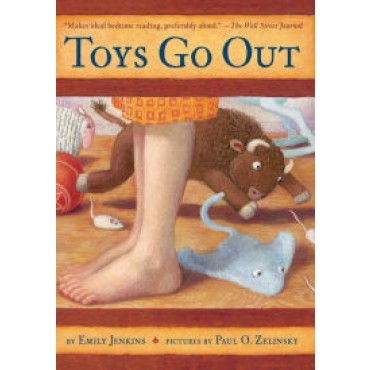 Toys Go Out: Being the Adventures of a Knowledgeable Stingray, a Toughy Little Buffalo, and Someone Called Plastic written by Emily Jenkins and illustrated by Paul O. Zelinsky
Toys Go Out: Being the Adventures of a Knowledgeable Stingray, a Toughy Little Buffalo, and Someone Called Plastic written by Emily Jenkins and illustrated by Paul O. Zelinsky
Hilarious and heart-warming, this chapter book is a perfect pick for kids wanting a laugh-out-loud funny book to read on their own. It also makes a perfect family read-aloud!
For 5th and 6th Grade (Ages 10-12):
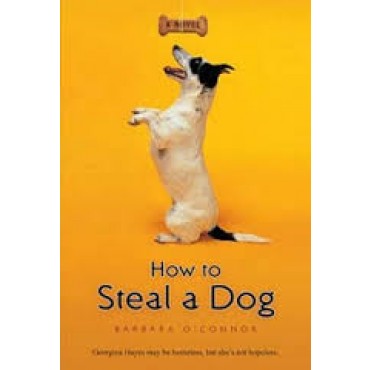 How to Steal a Dog written by by Barbara O’Connor
How to Steal a Dog written by by Barbara O’Connor
Empathy, understanding, and a clearer sense of right and wrong – these are just some of the lessons kids will take away from this wonderful, highly accessible book about a well-intentioned girl whose frustrations get the better of her when her family loses their apartment and is forced to live out of their car.
Grades 7 & up (Ages 13+):
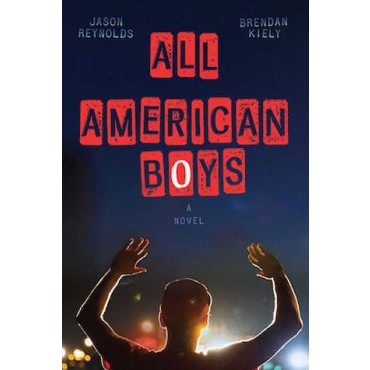 All-American Boys written by Jason Reynolds & Brendan Kiely
All-American Boys written by Jason Reynolds & Brendan Kiely
Teens will be both won over and bowled over by this tremendous novel about prejudice, power, and police brutality. Fantastic fuel for discussion, it’s A 2016 Coretta Scott King Author Honor book and the recipient of the Walter Dean Myers Award for Outstanding Children’s Literature!
The post Monthly Book List: Our Five Favorite Books for April appeared first on First Book Blog.

 The We Need Diverse Books organization has revealed the winning and honor books for the inaugural Walter Dean Myers Award for Outstanding Children’s Literature. This prize, named after the late Walter Dean Myers, has also become known as “The Walter.”
The We Need Diverse Books organization has revealed the winning and honor books for the inaugural Walter Dean Myers Award for Outstanding Children’s Literature. This prize, named after the late Walter Dean Myers, has also become known as “The Walter.”
All American Boys, a young adult novel written by Jason Reynolds and Brendan Kiely, was named the winner. Enchanted Air, a poetic memoir written by Margarita Engle, and X, a novel written by Ilyasah Shabazz and Kekla Magoon, were both named honor titles. We’ve linked to free samples of all the recognized books below.
Here’s more from the We Need Diverse Books blog post: “The Judges Panel reviewed titles published during the 2015 calendar year by diverse authors whose work featured a diverse main character or addressed diversity in a meaningful way. In the case of author pairs (or author-illustrator pairs), at least one member of the pair must be from an underrepresented community. The books covered many genres and included both fiction and nonfiction works. The award’s mission is to honor the memory of Walter Dean Myers and his literary heritage, as well as celebrate diversity in teen literature.”
Free Samples of The Walter Winner and Honor Books
Winner: All American Boys by Jason Reynolds & Brendan Kiely
Honor: Enchanted Air: Two Cultures, Two Wings by Margarita Engle
Honor: X: A Novel by Ilyasah Shabazz & Kekla Magoon
The Boy in the Black Suit by Jason Reynolds. Atheneum Books for Young Readers. 2015. Reviewed from ARC.
by Jason Reynolds. Atheneum Books for Young Readers. 2015. Reviewed from ARC.

The Plot: Everything has been different since Matt's mom died. It's his senior year of high school, but her loss makes him feel like a stranger. His father isn't coping.
Matt's done well in school, so he has half-days. He was supposed to do a work-study program, but, well, with his mom dying he wasn't in school so he lost his place. Still, he needs a job to fill up his time and to earn money to help his dad out.
At first when his neighbor Mr. Ray offers a job in his funeral home, Matt thinks "no way." He finds a strange sort of comfort in seeing the sorrow of others. Then he meets Lovey, who has lost her mother and now her grandmother, and it makes him rethink how he's been living, and how he's been grieving.
The Good: What is so frustrating about The Boy in the Black Suit is it sounds like a dead parent book. And, I guess, it is. Matt's mom has just died, and he that loss, her loss, is shattering, and part of this book is how he lives through that. But it's so much more than that, including funny and romantic.
Matt is an only child, and his parents were very much still in love, and his father takes his wife's loss badly. He starts drinking and ends up in the hospital, leaving Matt alone. Matt isn't really alone: there is his best friend, Chris, who proves to be a good friend by not treating Matt any different. And there is Mr. Ray, who Matt thought of as the old guy neighbor and who now becomes a mentor. And then there is Lovey....
I don't want to say Matt is happy when he sees others cry and break at a loved one's funeral. Instead, it makes him feel less alone in his own loss. It's cathartic. And Mr. Ray understands; he's had his own losses. Matt's dad and Mr. Ray show Matt ways of grieving, and then Lovey shows him another -- a way that mourns while celebrating. Matt falls for Lovey, but also sees another way forward.
Also good: The Boy in the Black Suit is set in Brooklyn, and there's a mix of people, from Matt's family and their brownstone to Chris's family in an apartment building. Matt describes his family as "I went from a not-so-fancy version of the Cosbys to a one-man family." Chris is being raised by a single mother; Lovey, by her grandmother. It's a variety of people and backgrounds, all in one same neighborhood.
Chris's mother is dead before the book begins, but her spirit and love is on every page. One thing his mom had done (even before she knew she had cancer) was to create a notebook of recipes, which she called "The Secret of Getting Girls, for Matty." It's partly a family joke, that girls like guys who cook. And it's partly her love for her son. And it's partly her saying Matty, yes, you need to know how to cook, for you. This notebook is lurking around, and part of the sweetness of this book is how Matt moves from living off fast food and take out, even though he knows how to cook and his this book, to being able to open the notebook without his heart breaking.
Amazon Affiliate. If you click from here to Amazon and buy something, I receive a percentage of the purchase price.
© Elizabeth Burns of A Chair, A Fireplace & A Tea Cozy


 Elena Mechlin has been promoted to literary agent at Pippin Properties, Inc.
Elena Mechlin has been promoted to literary agent at Pippin Properties, Inc.
Prior to joining the agency in 2009, Mechlin worked at Fulcrum Publishing, Simon & Schuster, and Random House.
Mechlin’s client list includes 2013 Newbery Medal-winning author Katherine Applegate, debut young-adult novelist Jason Reynolds, picture-book author Beth Ferry and illustrator Rob Dunlavey. On submissions, she represents clients who create all types of children’s literature projects from picture books through young-adult.
New Career Opportunities Daily: The best jobs in media.
 Love you, Hug You, Read to You! / ¡Te Amo, Te Abrazo, Leo Contigo! by Tish Rabe
Love you, Hug You, Read to You! / ¡Te Amo, Te Abrazo, Leo Contigo! by Tish Rabe Penguin Problems written by Jory John and illustrated by Lane Smith
Penguin Problems written by Jory John and illustrated by Lane Smith One Vote, Two Vote, I Vote, You Vote! by Bonnie Worth
One Vote, Two Vote, I Vote, You Vote! by Bonnie Worth March, Book 3 by John Lewis
March, Book 3 by John Lewis










 Q. Do you see your teenage self in any of your novels? If so, which one(s) and in what ways?
Q. Do you see your teenage self in any of your novels? If so, which one(s) and in what ways?







 Elena Mechlin has been promoted to literary agent at Pippin Properties, Inc.
Elena Mechlin has been promoted to literary agent at Pippin Properties, Inc.
As you know, I’m always on the look-out for books that help American children get a better sense of the range of life in Africa. And so am very excited to read this one and learn more about how it came into being.
I’ll be waiting eagerly for your review.
I look forward to hearing your thoughts on it. I have to say, my mentors kept it on my path!
I was honored to meet Leah at a Highlights Foundation workshop this year. And her book sounds so fantastic I can hardly wait to read it! What a gorgeous cover — I’m thrilled for Leah.
Hi Joanne, Thank you!
It started as a short story during a trip to Senegal.
Betsy, Thanks again!
And the winner of my twitter contest is: Kiiette Walker Parker.
I just love this answer to why she reads/loves MG lit: Through MG, young minds can explore, run, see, taste, and absorb the essence of life via words, and older ones can be renewed. #whyMGlit
[…] & Schuster/Atheneum in 2017)! Her novel began as part of her creative thesis at Spalding. Follow this link to Betsy Bird’s Fuse #8 blog and the beautiful artwork for Leah’s One Shadow On The Wall. […]